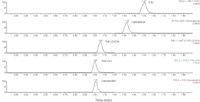Extraction of THC and Metabolites from Plasma Using ISOLUTE SLE+ Columns and (96-well Plates with LC–MS–MS Analysis
Biotage Application Note
A simple and efficient supported liquid extraction (SLE) procedure for the extraction of THC and metabolites from human plasma at low levels has been developed. ISOLUTE SLE+ columns and plates offer a simple, fast and effective alternative to traditional liquid-liquid extraction providing high analyte recoveries, eliminating emulsion formation and minimizing matrix effects in LC–MS–MS analysis.
Introduction
Widespread legislation against the use of cannabis has led to the necessity for rapid and reliable methods for the analysis and quantification of cannabinoids and metabolites. The most prevalent markers in biological samples taken from cannabis abusers are Δ9tetrahydrocannanbinol (THC), cannabidiol, cannabinol in addition to the major THC metabolites; 11-hydoxy-Δ9-THC and 11-nor-9-carboxy-Δ9-THC.
This application note describes the extraction of THC and metabolites from a 200 µL plasma sample using the ISOLUTE SLE+ 200 96-well plate (part #820-0200-P01). Method parameters have been optimized to maximize recoveries and minimize ion suppression in LC–MS analysis.
Experimental
Supported liquid extraction
Sample pre-treatment: Dilute 100 µL plasma sample 1:1 (v/v) with 1% aqueous formic acid.
Sample loading: Load pre-treated plasma (200 µL) samples onto the plate and apply a pulse of vacuum to initiate flow. Leave the samples to absorb for 5 minutes.
Analyte elution: Elution 1: Apply 500 µL dichloromethane, then a short pulse of vacuum and wait 5 minutes.
Elution 2: Apply a further 500 µL aliquot of dichloromethane, wait 5 minutes then apply a short pulse of vacuum to ensure complete elution.
Post extraction: Evaporate eluate to dryness and reconstitute in 500 µL of 0.1% formic acid in water/acetonitrile (50:50, v/v).
LC–MS–MS
Instrument: Waters Acquity UPLC (Waters Corp., Milford, Massachusetts, USA)
Column: Acquity UPLC BEH C18 column (1.7 µm, 100 × 2.1 mm i.d.) (Waters)
Mobile phase: A: 0.1% formic acid aq and B: 0.1% formic acid in methanol. Run isocratically at a flow-rate of 0.5 mL/min 10% A and 90% B
Injection volume: 5 µL
Column temperature: 35 °C
Instrument: Quattro Premier XE triple quadrupole mass spectrometer (Waters Corp., Manchester, UK) equipped with an electrospray interface for mass analysis
Desolvation temperature: 450 °C
Ion source temperature: 150 °C
Collision gas pressure: 3.46 × 10–3 mbar
Results
Recoveries above 80% with RSDs below 10% (n = 6) were demonstrated for all analytes. Figure 1 shows the SRM chromatogram of THC and metabolites extracted from human plasma using this procedure.

Figure 1: SRM chromatogram of extracted THC and metabolites.
Conclusions
This method demonstrates robust and effective extraction of THC and metabolites using ISOLUTE SLE+ 200 96-well plates. The method can easily be scaled up and optimized for larger sample volumes (up to 1 mL) using ISOLUTE SLE+ columns.
References
1. L. Williams, Extraction of THC and metabolites from Plasma using ISOLUTE SLE+, Application Note AN 723, available from www.biotage.com (2010).

Biotage AB
Kungsgatan 76 , SE-753 18 Uppsala, Sweden
tel.: +46 18 56 59 00 fax: +46 18 59 19 22
E-mail: info@biotage.com Website: www.biotage.com

Removing Double-Stranded RNA Impurities Using Chromatography
April 8th 2025Researchers from Agency for Science, Technology and Research in Singapore recently published a review article exploring how chromatography can be used to remove double-stranded RNA impurities during mRNA therapeutics production.



















